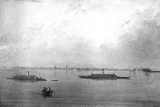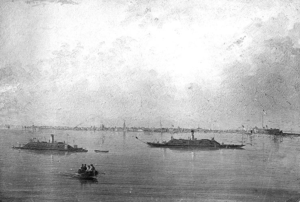
CSS Chicora
Encyclopedia
CSS Chicora was a Confederate ironclad ram that fought in the American Civil War
. She was built under contract at Charleston
, South Carolina
in 1862. James M. Eason built her to John L. Porter
's plans, using up most of a $300,000 State appropriation for construction of marine batteries; Eason received a bonus for "skill and promptitude." Her iron shield was 4" thick, backed by 22" of oak and pine, with 2-inch armor at her ends. Keeled in March, she was commissioned in November, Commander
John Randolph Tucker, CSN
assuming command.
In thick, predawn haze on January 31, 1863, Chicora and CSS Palmetto State
raided the Federal blockading force of unarmored ships lying just outside the entrance to Charleston Harbor. With ram and gun, Palmetto State forced USS Mercedita to surrender, then disabled USS Keystone State
, who had to be towed to safety. Chicora meanwhile engaged other Union
ships in a long-range gun duel, from which she emerged unscathed to withdraw victoriously to shelter inside the harbor.
 She took part in the defense of the forts at Charleston on April 7 when they were attacked by a squadron of ironclad monitors under Rear Admiral
She took part in the defense of the forts at Charleston on April 7 when they were attacked by a squadron of ironclad monitors under Rear Admiral
Samuel Francis du Pont
, USN
. The Federal ships were forced to retire for repairs and did not resume the action.
Chicora was actively employed in the fighting around Charleston during 1863 and 1864. Her valuable services included the transporting of troops during the evacuation of Morris Island
, and the bombardment of Forts Sumter
, Gregg
, and Wagner
. In August 1863 she had the distinction of furnishing the first volunteer officer and crew for the Confederate Submarine Torpedo Boat H. L. Hunley.
She was destroyed by the Confederates when Charleston was evacuated on February 18, 1865.
American Civil War
The American Civil War was a civil war fought in the United States of America. In response to the election of Abraham Lincoln as President of the United States, 11 southern slave states declared their secession from the United States and formed the Confederate States of America ; the other 25...
. She was built under contract at Charleston
Charleston, South Carolina
Charleston is the second largest city in the U.S. state of South Carolina. It was made the county seat of Charleston County in 1901 when Charleston County was founded. The city's original name was Charles Towne in 1670, and it moved to its present location from a location on the west bank of the...
, South Carolina
South Carolina
South Carolina is a state in the Deep South of the United States that borders Georgia to the south, North Carolina to the north, and the Atlantic Ocean to the east. Originally part of the Province of Carolina, the Province of South Carolina was one of the 13 colonies that declared independence...
in 1862. James M. Eason built her to John L. Porter
John L. Porter
John Luke Porter , whose father was a shipwright at Portsmouth, Virginia, was born in 1813. He became a United States Navy civilian employee during the 1840s and a Naval Constructor in 1859. After resigning from the U.S. Navy in May 1861, he began working for the Confederate States Navy at the...
's plans, using up most of a $300,000 State appropriation for construction of marine batteries; Eason received a bonus for "skill and promptitude." Her iron shield was 4" thick, backed by 22" of oak and pine, with 2-inch armor at her ends. Keeled in March, she was commissioned in November, Commander
Commander
Commander is a naval rank which is also sometimes used as a military title depending on the individual customs of a given military service. Commander is also used as a rank or title in some organizations outside of the armed forces, particularly in police and law enforcement.-Commander as a naval...
John Randolph Tucker, CSN
Confederate States Navy
The Confederate States Navy was the naval branch of the Confederate States armed forces established by an act of the Confederate Congress on February 21, 1861. It was responsible for Confederate naval operations during the American Civil War...
assuming command.
In thick, predawn haze on January 31, 1863, Chicora and CSS Palmetto State
CSS Palmetto State
CSS Palmetto State, an ironclad ram, was built by Cameron and Co., Charleston, South Carolina in January 1862, under the supervision of Flag Officer D. N. Ingraham, CSN. She was readied for service by September 1862 when Lieutenant Commander John Rutledge, CSN, was placed in command. Her armor was...
raided the Federal blockading force of unarmored ships lying just outside the entrance to Charleston Harbor. With ram and gun, Palmetto State forced USS Mercedita to surrender, then disabled USS Keystone State
USS Keystone State
USS Keystone State may refer to:, was a wooden side wheel steamer purchased by the US Navy 10 June 1861 and sold at auction 15 September 1865, was the former sloop-of-war St. Louis renamed Keystone State on 30 November 1904...
, who had to be towed to safety. Chicora meanwhile engaged other Union
United States
The United States of America is a federal constitutional republic comprising fifty states and a federal district...
ships in a long-range gun duel, from which she emerged unscathed to withdraw victoriously to shelter inside the harbor.

Rear admiral (United States)
Rear admiral is a naval commissioned officer rank above that of a commodore and captain, and below that of a vice admiral. The uniformed services of the United States are unique in having two grades of rear admirals.- Rear admiral :...
Samuel Francis du Pont
Samuel Francis du Pont
Samuel Francis Du Pont was an American naval officer who achieved the rank of Rear Admiral in the United States Navy, and a member of the prominent Du Pont family; he was the only member of his generation to use a capital D...
, USN
United States Navy
The United States Navy is the naval warfare service branch of the United States Armed Forces and one of the seven uniformed services of the United States. The U.S. Navy is the largest in the world; its battle fleet tonnage is greater than that of the next 13 largest navies combined. The U.S...
. The Federal ships were forced to retire for repairs and did not resume the action.
Chicora was actively employed in the fighting around Charleston during 1863 and 1864. Her valuable services included the transporting of troops during the evacuation of Morris Island
Morris Island
Morris Island is an 840 acre uninhabited island in Charleston Harbor in South Carolina, accessible only by boat. The island lies in the outer reaches of the harbor and was thus a strategic location in the American Civil War.-History:...
, and the bombardment of Forts Sumter
Fort Sumter
Fort Sumter is a Third System masonry coastal fortification located in Charleston Harbor, South Carolina. The fort is best known as the site upon which the shots initiating the American Civil War were fired, at the Battle of Fort Sumter.- Construction :...
, Gregg
Fort Gregg
Fort Gregg was a Confederate fort located near Petersburg, Virginia.The battle for Fort Gregg occurred on April 2, 1865, in Dinwiddie County near the outskirts of Petersburg.-External links:* at the Historical Markers Database...
, and Wagner
Fort Wagner
Fort Wagner was a beachhead fortification on Morris Island, South Carolina, that covered the southern approach to Charleston harbor...
. In August 1863 she had the distinction of furnishing the first volunteer officer and crew for the Confederate Submarine Torpedo Boat H. L. Hunley.
"A Lieutenant’s commission in the Confederate States Navy was conferred on me, with orders to report for duty on the ironclad Chicora at Charleston. My duties were those of a deck officer, and I had charge of the first division. On the occasion of the attack upon the blockading squadron ... It was my part, on the memorable morning, to aim and fire one effective shell into the Keystone State while running down to attack us, which (according to Captain LeRoy’s report), killing twenty-one men and severely wounding fifteen, caused him to haul down his flag in token of surrender. The enemy now kept at a respectful distance while preparing their ironclad vessels to sail up more closely. Our Navy Department continued slowly to construct more of these rams, all on the same general plan, fit for little else than harbor defense." -- William T. Glassell, Lt. CSN
She was destroyed by the Confederates when Charleston was evacuated on February 18, 1865.
External links
- http://www.specialbooks.com/Prisoners.htm

